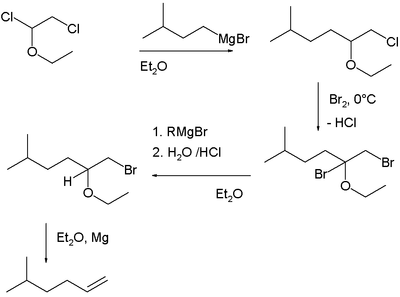
Boord olefin synthesis
Encyclopedia
The Boord olefin synthesis is an organic reaction
forming alkene
s from ether
s carrying a halogen
atom 2 carbons removed from the oxygen atom (β-halo-ethers) catalyzed by a metal such as magnesium
or zinc
. The reaction, discovered by Cecil E. Boord in 1930 is a classic named reaction with high yields and broad scope .
The reaction type is an elimination reaction
with magnesium forming an intermediate Grignard reagent. The alkoxy group is a poor leaving group
and therefore a E1cB elimination reaction
mechanism is proposed .The original publication describes the organic synthesis
of the compound isoheptene in several steps with the elimination the final one:
In a 1931 publication the scope is extended to 1,4-dienes
with magnesium replaced by zinc
(see also: Barbier reaction
). In the first part of the reaction the allyl
Grignard acts as a nucleophile in nucleophilic aliphatic substitution.
Organic reaction
Organic reactions are chemical reactions involving organic compounds. The basic organic chemistry reaction types are addition reactions, elimination reactions, substitution reactions, pericyclic reactions, rearrangement reactions, photochemical reactions and redox reactions. In organic synthesis,...
forming alkene
Alkene
In organic chemistry, an alkene, olefin, or olefine is an unsaturated chemical compound containing at least one carbon-to-carbon double bond...
s from ether
Ether
Ethers are a class of organic compounds that contain an ether group — an oxygen atom connected to two alkyl or aryl groups — of general formula R–O–R'. A typical example is the solvent and anesthetic diethyl ether, commonly referred to simply as "ether"...
s carrying a halogen
Halogen
The halogens or halogen elements are a series of nonmetal elements from Group 17 IUPAC Style of the periodic table, comprising fluorine , chlorine , bromine , iodine , and astatine...
atom 2 carbons removed from the oxygen atom (β-halo-ethers) catalyzed by a metal such as magnesium
Magnesium
Magnesium is a chemical element with the symbol Mg, atomic number 12, and common oxidation number +2. It is an alkaline earth metal and the eighth most abundant element in the Earth's crust and ninth in the known universe as a whole...
or zinc
Zinc
Zinc , or spelter , is a metallic chemical element; it has the symbol Zn and atomic number 30. It is the first element in group 12 of the periodic table. Zinc is, in some respects, chemically similar to magnesium, because its ion is of similar size and its only common oxidation state is +2...
. The reaction, discovered by Cecil E. Boord in 1930 is a classic named reaction with high yields and broad scope .
The reaction type is an elimination reaction
Elimination reaction
An elimination reaction is a type of organic reaction in which two substituents are removed from a molecule in either a one or two-step mechanism...
with magnesium forming an intermediate Grignard reagent. The alkoxy group is a poor leaving group
Leaving group
In chemistry, a leaving group is a molecular fragment that departs with a pair of electrons in heterolytic bond cleavage. Leaving groups can be anions or neutral molecules. Common anionic leaving groups are halides such as Cl−, Br−, and I−, and sulfonate esters, such as para-toluenesulfonate...
and therefore a E1cB elimination reaction
E1cB elimination reaction
The E1cB elimination reaction is a special type of elimination reaction in organic chemistry. This reaction mechanism explains the formation of alkenes from alkyl halides through a carbanion intermediate given specified reaction conditions and specified substrates. The abbreviation stands for ...
mechanism is proposed .The original publication describes the organic synthesis
Organic synthesis
Organic synthesis is a special branch of chemical synthesis and is concerned with the construction of organic compounds via organic reactions. Organic molecules can often contain a higher level of complexity compared to purely inorganic compounds, so the synthesis of organic compounds has...
of the compound isoheptene in several steps with the elimination the final one:
In a 1931 publication the scope is extended to 1,4-dienes
Diene
In organic chemistry a diene or diolefin is a hydrocarbon that contains two carbon double bonds.Conjugated dienes are functional groups, with a general formula of CnH2n-2. Dienes and alkynes are functional isomers...
with magnesium replaced by zinc
Zinc
Zinc , or spelter , is a metallic chemical element; it has the symbol Zn and atomic number 30. It is the first element in group 12 of the periodic table. Zinc is, in some respects, chemically similar to magnesium, because its ion is of similar size and its only common oxidation state is +2...
(see also: Barbier reaction
Barbier reaction
The Barbier reaction is an organic reaction between an alkyl halide and a carbonyl group as an electrophilic substrate in the presence of magnesium, aluminium, zinc, indium, tin or its salts. The reaction product is a primary, secondary or tertiary alcohol...
). In the first part of the reaction the allyl
Allyl
An allyl group is a substituent with the structural formula H2C=CH-CH2R, where R is the connection to the rest of the molecule. It is made up of a methylene , attached to a vinyl group . The name is derived from the Latin word for garlic, Allium sativum. Theodor Wertheim isolated an allyl...
Grignard acts as a nucleophile in nucleophilic aliphatic substitution.




